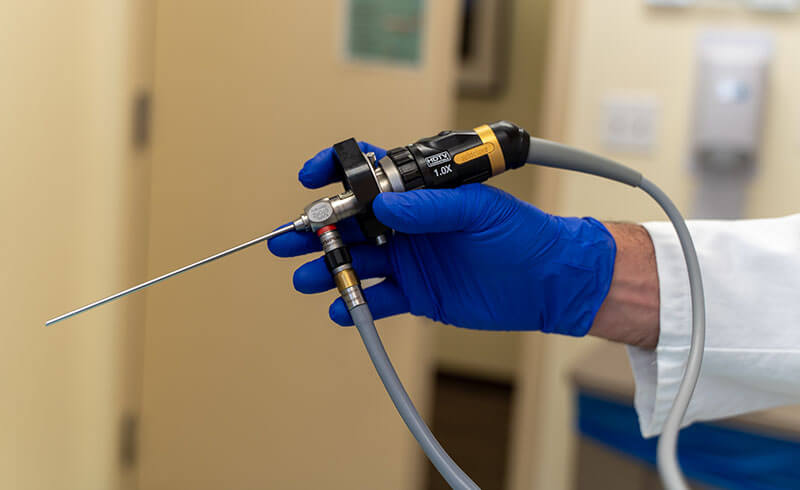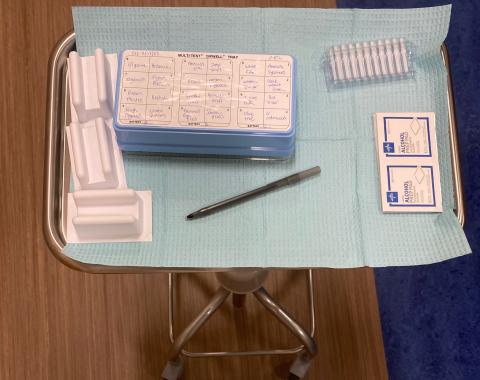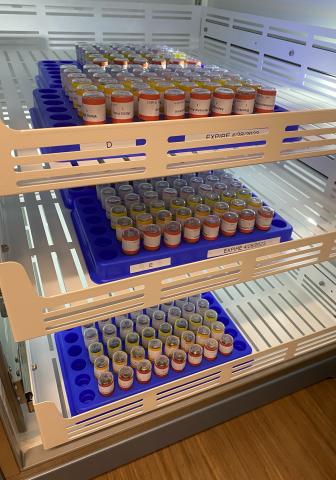Allergy Clinic Overview
Allergy symptoms most commonly occur in the nose and upper airway, and may be present during a specific season or all year long. Allergy testing is offered to determine the specific allergens someone is allergic to, and treatment options include medication, surgery, and/or allergy shots.


What to Expect at your Allergy Testing Appointment
After your physician has determined you are a good candidate for allergy testing, you will be set up with an allergy testing appointment.
Allergy testing is used to determine an individual’s allergies.
- This can be done with a blood test, which, while not as accurate as other forms of testing, can be a quick and easy way to determine your allergies.
- Skin testing is a more accurate way of testing for allergies.
Allergy skin tests take over an hour in the allergy clinic and are performed by trained providers. Rarely, allergy skin tests can cause a severe and immediate allergic reaction, so it’s important that the testing is performed in a clinic that is equipped with the appropriate emergency equipment and medications.
The provider will ask about medications you are taking and any recent illnesses. If your asthma is flaring up, or if you have symptoms of a cold, we may reschedule your allergy testing because this can put you at higher risk for a severe allergic reaction.
We will be using your arms and back for skin testing, so we may ask you to change into a hospital gown. You may notice that once we start the allergy test, your back becomes itchy. That is expected.

There are several medications that you may be asked to stop prior to skin testing for allergies, either for safety, or to make sure that accurate results are obtained. This will be covered prior to your skin testing appointment.
- Allergy Skin Prick Test: This test will use a small pinprick device to deliver a small amount of allergen into your skin. We may test up to 40 different substances that will include pollens from trees, grasses and weeds, animal dander molds, and dust. The testing is not painful; the skin prick only punctures the most superficial layer of skin.
- We start by cleaning your back with alcohol. A device is used to deliver multiple different allergens onto different sites on your back. We use a washable marker to identify the marks. In addition to the allergens, we also prick your skin with histamine and glycerine. These act as positive and negative controls to ensure the accuracy of the skin test.
- Once we finish with the skin pricks, we wait 15 minutes and then check for signs of a positive reaction. A positive test will often feel itchy and will have a red raised bump. We then measure each bump and record the results. Finally, the marks are removed from your skin with an alcohol pad.
Intradermal testing: Depending on the results of your skin prick testing, we may then proceed with an intradermal test, where a small volume of allergen is injected just under the skin, like a TB test. This will help us clarify allergic reactions, which may have been inconclusive on the skin prick test. We wait an additional 15 minutes before reading and measuring the results. This testing is performed on the arm.

Once the allergy testing is complete, the allergy specialist will interpret the test results and talk to you about your treatment options.
Before leaving the office, the allergy specialist will look at the results of your test, and consider the results in context to your symptoms and history. S/he will put a treatment plan together and discuss your options with you. This may include changes to your local environment, like using allergy bedding, a change in your medications, or allergy immunotherapy/desensitization with the goal of reducing or eliminating your allergy symptoms.
Conditions and Treatment
Environmental allergies are a result of an immune response to substances in your surroundings that are otherwise harmless, like tree or grass pollen, or dust mites. The symptoms of environmental allergies differ from person to person but may include itchy, watery eyes, runny nose, nasal congestion, facial pressure, decreases sense of smell, wheezing or shortness of breath, cough, post-nasal dip, or ear pressure/popping.
Treatment of environmental allergies depends on the symptoms you have and their severity. Your allergy provider will work with you to determine the right treatment for the symptoms your individual symptoms. Allergy testing can confirm this diagnosis and can guide lifestyle modifications to control your symptoms. Often, symptoms can be controlled with medications, environmental measures, or allergy immunotherapy. Our trained allergy providers offer allergy testing and allergy immunotherapy (shots or drops).
- Sinusitis/Nasal Polyps
- Nasal breathing problems
- Turbinate hypertrophy
- Deviated septum
- Anosmia (loss of sense of smell)
Patient Education
Allergy Immunotherapy
Allergy immunotherapy is a prolonged treatment, usually 3-5 years, consisting of shots in the upper arm or drops under the tongue, which are meant to desensitize you to your allergies. Each shot or drop contains a small amount of one or many allergens, which have been individualized to you based on your allergy testing. The goal of this treatment is to stimulate your own immune system so that it learns to tolerate the substances that normally cause you to have allergy symptoms. We aim to challenge your immune system to develop tolerance, but we try not to overstimulate your immune system to have a severe allergic reaction. While it is rare, severe systemic reactions like anaphylaxis can happen and your provider will be careful to monitor your reaction over time. Asthma flares and upper respiratory tract infections may predispose you to having a severe reaction and so your provider will ask about your health prior to delivering your immunotherapy dose.
Allergy drops, or sublingual immunotherapy, are similar to allergy shots in that they combine allergy extracts that are individuals to a patient. Instead of delivering immunotherapy with a shot, patients will be given a bottle with liquid allergy extracts which they drop under their tongue. Once you are given your initial dose, patients take the bottle home to administer the allergy drops daily. The allergy drops usually last 2-3 months, and then are refilled in our allergy clinic. Therefore, patients do not have to come to the allergy clinic as often as patients given allergy shots. Also, while the drops do have some associated risks, they are less likely to cause severe reactions compared to shots. In spite of these advantages, allergy drops are considered off label use of allergen extracts and so are not often covered by insurance. As a result, there is an out of pocket cost associated with allergy drops. Your allergy providers will discuss this with you during your allergy consultation.
Every 2-3 months you will come back to clinic to get your new allergy drop vial. With each new vial we will administer the first dose in clinic and ask that you stay in the clinic for 30 minutes after your dose. Although severe reactions are rare, we do this to make sure you do not develop any reactions that will need emergent treatment.
Risks: Allergy testing and allergy immunotherapy are a safe and effective way of diagnosing and treating your allergies. We do encounter some side effects of testing and treatment, which are most commonly very mild, but rarely can be life threatening.
Benefit: Allergy immunotherapy does not stop your symptoms overnight. That is why it’s important to first discuss your symptoms with your allergy provider so that you can be started on medications to control your symptoms. Your allergy immunotherapy should begin to improve your symptoms within the first year of treatment. This should be the most noticeable in the 2nd year. By year 3 of treatment, most people are desensitized to the allergens contained in the allergy shot or drop and should no longer have significant symptoms when exposed to these substances.
What are possible reactions or side effects that can occur with Allergy Testing and/or Immunotherapy?
Pain, bleeding, itching, redness, swelling, bruising at the testing site
Mild side effects are common and include itchy lips or mouth within minutes to hours of the dose. This can occur in up to 1/3 of patients, usually in the first 2 weeks of therapy and then goes away as therapy continues. These reactions may be treated with an oral antihistamine. We recommend taking a daily antihistamine for the first several weeks of SLIT to prevent these symptoms until you tolerate your maintenance dose.
Another rare, delayed reaction to SLIT is eosinophilic esophagitis, where your esophagus swells as a result of swallowing the allergy drops. Symptoms include heartburn and/or difficulty swallowing. Symptoms are not permanent and resolve with discontinuation of SLIT.
These are relatively common and are limited to symptoms around the site of injection. These symptoms can include redness, itching, swelling, bruising, bleeding, and/or pain. The reactions may occur several hours after the injection. You should notify the nurse if your local reaction exceeds two inches in diameter or lasts until the following day.
- Lip swelling
- Eye itching, redness and swelling
- Sneezing, nasal itching, nasal congestion
- Hives, swelling
- Nausea, vomiting, abdominal cramping, diarrhea
- Asthma symptoms: cough, wheeze, shortness of breath
Severe side effects are uncommon; however, all patients should be aware of risk for severe allergic reactions. We prescribe EpiPens to all our immunotherapy patients for this reason. The risks of general reactions are much lower for patients getting allergy drops and so that is why we think it is safe for allergy drops to be taken at home.
Urticarial Reaction: includes symptoms of rash, swelling and itching of more than one part of the body. This can be moderately uncomfortable, mostly due to the itching. This can happen a few minutes but also up to several hours after getting your allergy shot or drop.
Angioedema: defined as swelling in any part of the body, both internal or external, like the tongue, lips, ears, throat, intestines, hands, feet, or any combination. This can also present with difficulty breathing or wheezing, and may progress to anaphylactic shock. Swelling of the upper or lower airway can result in suffocation and shock which can result in death. This reaction most commonly happens within minutes of the injection or drop which is why we monitor every patient for 30 minutes after their immunotherapy. While this reaction is extremely rare, it is very important to recognize the signs so that you can get treatment immediately.
Anaphylactic Shock: can present with acute shortness of breath, low blood pressure and loss of consciousness. Although rare, it is important that the signs of this reaction are recognized so that you can be treated promptly. Although anaphylaxis typically happens within minutes of taking the drops, cases have occurred hours later. Signs and symptoms of anaphylaxis include but are not limited to:
- Shortness of breath or wheezing
- Throat tightness
- Coughing
- Facial swelling, most commonly lips or tongue
- Rash or Itchy skin
- Feeling of doom or sudden anxiety
- Chest fluttering or pain
- Flushing or feeling of sudden warmth
- Nausea/vomiting
- Stomach cramping
As stated above, these generalized reactions are quite rare, but if they do happen, they are likely to occur minutes after your allergy shot or drop. This is why we monitor patients for 30 minutes after each allergy shot and each new drop vial. The clinic is equipped and ready to treat these reactions if they occur. If you develop any of these severe reactions after you have left the doctor’s office, you should go to the nearest emergency room. Do not hesitate to administer your EpiPen if any of the symptoms happen outside of the clinic setting.
Severe reactions happen more commonly in patients who are feeling unwell or are having a flare of their asthma. This is why it is especially important for you to tell you allergy provider if you are feeling unwell or if your asthma is acting up. If you had symptoms after your previous allergy shot, this is also important information to relay when you come in for your next shot.

